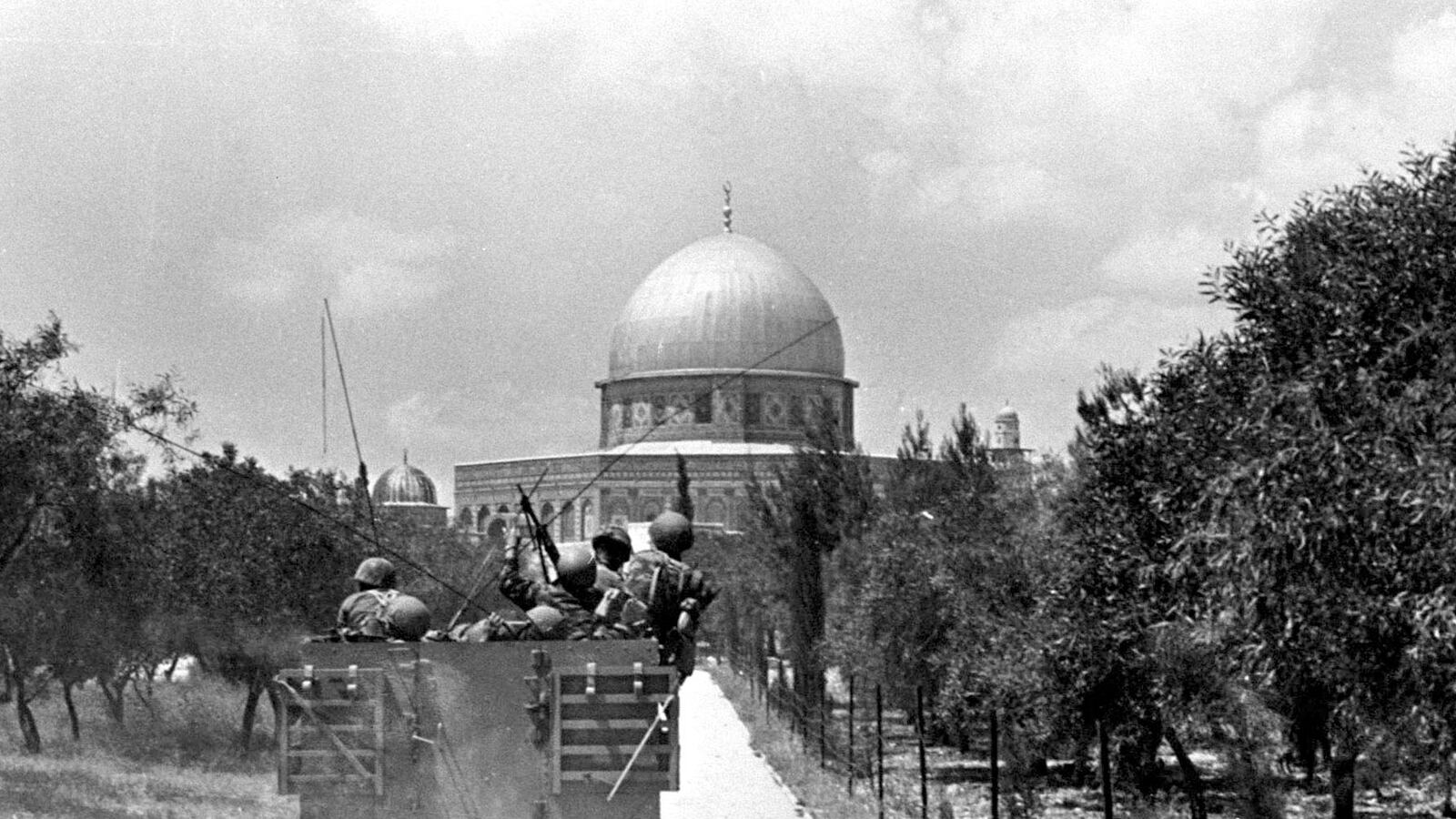The problem of Jerusalem—meaning East Jerusalem, with the Old City at its core—has been and remains a major stumbling block to Israeli-Arab peace. At least ostensibly, it was the rock on which the Clinton-Arafat-Barak talks foundered in Camp David in July 2000, when Arafat serially rejected the various solutions proposed by Clinton to the Temple Mount conundrum (Israeli-Palestinian condominium, UN Security Council control, a division of sovereignty, with the Arabs controlling the surface area, with its sacred mosques, and the Jews sovereign over the mount's "interior" or sub-surface, where, presumably are found the ruins of Solomon's and Herod's temples. The Temple Mount is in the southeastern corner of the Old City).
So perhaps how the problem arose—how East Jerusalem fell into Israeli hands in the Six-Day War—merits a fresh look.

Such a look is provided, in great detail and with endless illuminating anecdote, by Abraham Rabinovich's The Battle for Jerusalem, originally published in 1972, which is now out in revised and updated form as an e-book. Rabinovich, who was in the city in June 1967 and subsequently worked, for decades, at The Jerusalem Post, interviewed dozens of soldiers and civilians: Israelis, Jordanians, Palestinians and foreign diplomats and UN personnel—who took part in the events of those three fateful days, June 5-7, in which the Middle East was radically transformed and the conflict rendered vastly more complicated.
Firstly, the war with Jordan was unwanted by Israel, and was initiated by King Hussein and his army, the Arab Legion, whose troops began firing at Jewish West Jerusalem, at Israel's international airport in Lydda (today Ben-Gurion International Airport) and at the Ramat David air base in the Jezreel Valley, at around 10 am on June 5, two hours after Israel launched its war against Egypt with a devastating pre-emptive strike against that country's air bases. The strike was forced on Israel by Egypt's remilitarization of the Sinai Peninsula, the closure of the Gulf of Eilat to Israeli shipping, and the removal of the UN peace-keeping force from Egypt-Israel border zone during the preceding weeks.
That morning, June 5, both before and after the Legionnaires started shooting, Israel twice attempted to persuade the Jordanians to desist: If you don't fire at us or if you stop immediately, we won't touch Jerusalem and the West Bank, Israeli Prime Minister Levi Eshkol assured the Jordanians through the UN and through the American Embassy. Despite the provocation, the Israelis held their fire for about two hoursâbut then joined battle after the Jordanians launched their aircraft against the Israeli coastal town of Netanya and sent in their infantry to conquer Government House, the UN HQ in the Middle East which sat atop a commanding height in southern Jerusalem, the biblical Hill of Evil Council or Jabel Mukabar.
The Egyptian President, Nasser, had told Hussein that his aircraft had caught the Israeli air force on the ground and punished it severely and his armored forces had crossed into the Negev. Hussein apparently believed him. Hussein's uncle, Sherif Nasser, had advised the King to stay out of the fight for 12 hours—and see which way the wind was blowing. Hussein didn't listen. (Rabinovich maintains that by that morning, the Legion was in effect under control of the Egyptian high command. I disagree.)
Until noon, the Israelis maintained a purely defensive deployment, and with a minimum of troops. But then matters changed dramatically. As the 16th (Jerusalem) Brigade prepared to move against the Jordanians, the head of the UN observer mission in the Middle East, Odd Bull, proposed a ceasefire. "[Israeli chief of general staff Yitzhak] Rabin and [Defense Minister] Dayan... agreed... if Jordan accepted it too." But the Jordanians continued shooting. The IDF then rushed the 55th (reserve) Paratroop Brigade to the city and the Jerusalem Brigade took Government House and adjoining Jordanian positions. The battle was on.
The paratroops had originally been scheduled to drop on El Arish, in Sinai, and had little knowledge of Jerusalem's terrain. The battalions and companies were assigned their objectives that evening and crossed the border, north of the Old City, during the night. All was improvisation and anarchy; they barely prepared, and the battles at Ammunition Hill and Sheikh Jarrah were accordingly confused and costly.
As Rabinovich tells it (and contrary, for example, to the thrust of Tom Segev's 1967), Israel went to war without thought of territorial expansion. "In the Jordanian sector, we are going forward in the knowledge that we will be obliged to pull out from [East] Jerusalem and the West Bank," Eshkol told his cabinet ministers late on June 5. Indeed, according Rabinovich it was the religious Cabinet ministers who were "most outspoken in opposing annexation of the Old City," arguing that the world would not accept Jewish rule over the Christian sites. But by June 6, the winds had changed. "The Cabinet wants the Old City," Eshkol told the defense minister Dayan.
The following day, after the 28th Paratroop Battalion took the Rockefeller Museum, just north of the Old City walls, but a day before the battle for the city ended, a team of Israeli archeologists descended on the building, which housed, among other artifacts, Jordan's share of the Dead Sea scrolls. The soldiers, who had battled the Legionnaires for 24 hours through the alleys and bunkers of East Jerusalem, politely demanded enlightenment. So Dr. Avraham Biran, the director of Israel's Antiquities Department, took "a score of bone-weary soldiers" "on one of the most unusual museum lecture tours ever given. Shots echoed through the galleries and glass display cases periodically shattered as Biran and his colleagues explained the significance of some of the finds." Later, the troops signed the museum's visitors registry, some in English, some in Hebrew. ("What beauty, fantastic" and "It was [a] pleasant [visit])."
Rabinovich makes clear that, throughout the war, it was Dayan who held back the army, first from reaching the banks of the Suez Canal, then from taking the Old City and, then, two days later, from assaulting the Golan Heights. But in the end, the momentum of battle, Israeli successes and Arab defeats and retreats, carried all before it. So the Israelis emerged, as Gershom Gorenberg called it, with an "accidental empire." Indeed, regarding the Old City, it was Dayan who declared: "We have returned to the holiest of our sites and will never again be separated from it"; Jerusalem will remain united and under Jewish control. Which is where we're at today.





